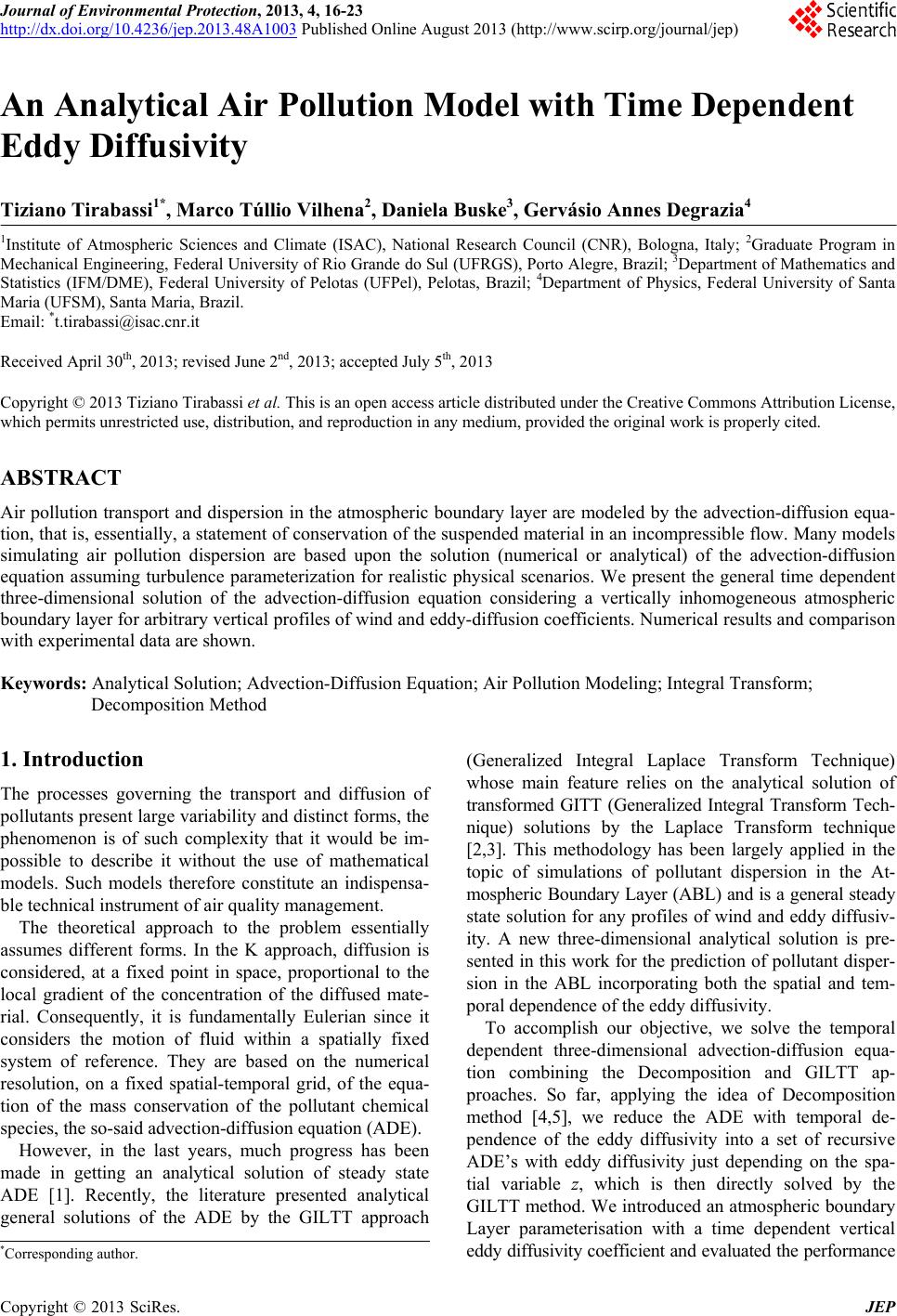 Journal of Environmental Protection, 2013, 4, 16-23 http://dx.doi.org/10.4236/jep.2013.48A1003 Published Online August 2013 (http://www.scirp.org/journal/jep) An Analytical Air Pollution Model with Time Dependent Eddy Diffusivity Tiziano Tirabassi1*, Marco Túllio Vilhena2, Daniela Buske3, Gervásio Annes Degrazia4 1Institute of Atmospheric Sciences and Climate (ISAC), National Research Council (CNR), Bologna, Italy; 2Graduate Program in Mechanical Engineering, Federal University of Rio Grande do Sul (UFRGS), Porto Alegre, Brazil; 3Department of Mathematics and Statistics (IFM/DME), Federal University of Pelotas (UFPel), Pelotas, Brazil; 4Department of Physics, Federal University of Santa Maria (UFSM), Santa Maria, Brazil. Email: *t.tirabassi@isac.cnr.it Received April 30th, 2013; revised June 2nd, 2013; accepted July 5th, 2013 Copyright © 2013 Tiziano Tirabassi et al. This is an open access article distributed under the Creative Commons Attribution License, which permits unrestricted use, distribution, and reproduction in any medium, provided the original work is properly cited. ABSTRACT Air pollution transport and dispersion in the atmospheric boundary layer are modeled by the advection-diffusion equa- tion, that is, essentially, a statement of conservation of the suspended material in an incompressible flow. Many models simulating air pollution dispersion are based upon the solution (numerical or analytical) of the advection-diffusion equation assuming turbulence parameterization for realistic physical scenarios. We present the general time dependent three-dimensional solution of the advection-diffusion equation considering a vertically inhomogeneous atmospheric boundary layer for arbitrary vertical profiles of wind and eddy-diffusion coefficients. Numerical results and comparison with experimental data are shown. Keywords: Analytical Solution; Advection-Diffusion Equation; Air Pollution Modeling; Integral Transform; Decomposition Method 1. Introduction The processes governing the transport and diffusion of pollutants present large variability and distinct forms, the phenomenon is of such complexity that it would be im- possible to describe it without the use of mathematical models. Such models therefore constitute an indispensa- ble technical instrument of air quality management. The theoretical approach to the problem essentially assumes different forms. In the K approach, diffusion is considered, at a fixed point in space, proportional to the local gradient of the concentration of the diffused mate- rial. Consequently, it is fundamentally Eulerian since it considers the motion of fluid within a spatially fixed system of reference. They are based on the numerical resolution, on a fixed spatial-temporal grid, of the equa- tion of the mass conservation of the pollutant chemical species, the so-said advection-diffusion equation (ADE). However, in the last years, much progress has been made in getting an analytical solution of steady state ADE [1]. Recently, the literature presented analytical general solutions of the ADE by the GILTT approach (Generalized Integral Laplace Transform Technique) whose main feature relies on the analytical solution of transformed GITT (Generalized Integral Transform Tech- nique) solutions by the Laplace Transform technique [2,3]. This methodology has been largely applied in the topic of simulations of pollutant dispersion in the At- mospheric Boundary Layer (ABL) and is a general steady state solution for any profiles of wind and eddy diffusiv- ity. A new three-dimensional analytical solution is pre- sented in this work for the prediction of pollutant disper- sion in the ABL incorporating both the spatial and tem- poral dependence of the eddy diffusivity. To accomplish our objective, we solve the temporal dependent three-dimensional advection-diffusion equa- tion combining the Decomposition and GILTT ap- proaches. So far, applying the idea of Decomposition method [4,5], we reduce the ADE with temporal de- pendence of the eddy diffusivity into a set of recursive ADE’s with eddy diffusivity just depending on the spa- tial variable z, which is then directly solved by the GILTT method. We introduced an atmospheric boundary Layer parameterisation with a time dependent vertical eddy diffusivity coefficient and evaluated the performance *Corresponding author. Copyright © 2013 SciRes. JEP 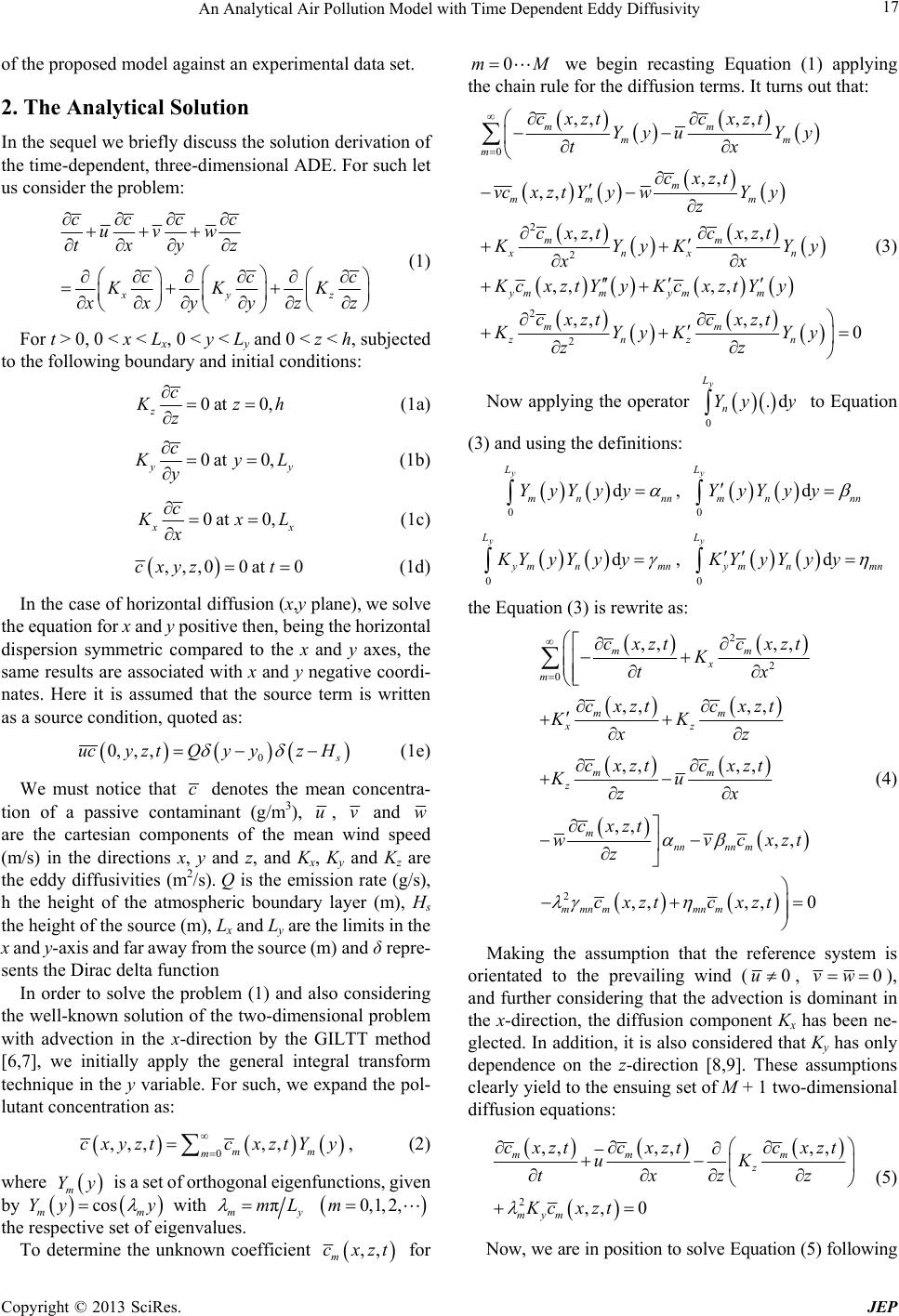 An Analytical Air Pollution Model with Time Dependent Eddy Diffusivity 17 of the proposed model against an experimental data set. 2. The Analytical Solution In the sequel we briefly discuss the solution derivation of the time-dependent, three-dimensional ADE. For such let us consider the problem: xyz KKK cccc uvw txyz ccc xy yz z (1) For t > 0, 0 < x < Lx, 0 < y < Ly and 0 < z < h, subjected to the following boundary and initial conditions: 0at 0, z Kz ch z (1a) 0at 0, y L y cy (1b) 0at 0, x L cx (1c) ,,,00at0xyzct (1d) In the case of horizontal diffusion (x,y plane), we solve the equation for x and y positive then, being the horizontal dispersion symmetric compared to the x and y axes, the same results are associated with x and y negative coordi- nates. Here it is assumed that the source term is written as a source condition, quoted as: 0 0,, , ucyz tQyyzH (1e) We must notice that c denotes the mean concentra- tion of a passive contaminant (g/m3), u, v and w are the cartesian components of the mean wind speed (m/s) in the directions x, y and z, and Kx, Ky and Kz are the eddy diffusivities (m2/s). Q is the emission rate (g/s), h the height of the atmospheric boundary layer (m), Hs the height of the source (m), Lx and Ly are the limits in the x and y-axis and far away from the source (m) and δ repre- sents the Dirac delta function In order to solve the problem (1) and also considering the well-known solution of the two-dimensional problem with advection in the x-direction by the GILTT method [6,7], we initially apply the general integral transform technique in the y variable. For such, we expand the pol- lutant concentration as: 0 ,,, ,, mm m cxyztc xztYy , (2) where is a set of orthogonal eigenfunctions, given by mm Yy with m Yy cos y π my mL the respective set of eigenvalues. 0,1,2,m To determine the unknown coefficient ,, m cxzt M for 0m we begin recasting Equation (1) applying the chain rule for the diffusion terms. It turns out that: 0 2 2 2 2 ,, ,, ,, ,, ,, ,, ,, ,, ,,,, 0 mm mm m m mm m mm xnxn ymm ymm mm znzn cxztcxzt Yy uYy tx cxzt vc xztY ywY y z c xztc xzt KYyKYy x x Kc xztY yKcxztY y cxztcxzt KYyKYy zz (3) Now applying the operator to Equation (3) and using the definitions: 0 .d y L n Yy y 0 d y L mn YyYyy nn , 0 d y L mn YyYyy nn 0 d y L mn KYyY yymn , 0 d y L mn KYyY yymn the Equation (3) is rewrite as: 2,, ,, 0 mm nm mnm cx ztcxzt 2 2 0 ,, ,, ,, ,, ,, ,, ,, ,, mm x m mm xz mm z m nnnn m cxzt cxzt K tx cxzt cxzt KK xz cxztcxzt Ku zx cxzt wvcxzt z (4) Making the assumption that the reference system is orientated to the prevailing wind (0u, 0vw ), and further considering that the advection is dominant in the x-direction, the diffusion component Kx has been ne- glected. In addition, it is also considered that Ky has only dependence on the z-direction [8,9]. These assumptions clearly yield to the ensuing set of M + 1 two-dimensional diffusion equations: 2 ,,,,,, ,, 0 mm m z mym cxztcxztcxzt uK txzz Kc xzt (5) Now, we are in position to solve Equation (5) following Copyright © 2013 SciRes. JEP  An Analytical Air Pollution Model with Time Dependent Eddy Diffusivity 18 the idea of the Decomposition method [4,5]. In fact to construct the solution, firstly it is considered that the time-dependent eddy diffusivity is written like: ,, zz z ztkztK z (6) where z z is the time averaged eddy diffusivity. By this assumption the Equation (5) reads like: 2 ,, ,, ,, ,, ,, , mm m zmy m z cxztcxzt u tx cxzt m zKc zz cxzt kzt zz xzt (7) According the idea of the Decomposition method, we consider that the solution of Equation (7) has the form: , 0 ,,,, J mmj j c xztcxzt (8) Now replacing Equation (8) in Equation (7), from the resulting equation we are able to construct the recursive set of advective-diffusive equations: ,0 ,0,0 2 ,0 ,1 ,1,1 2 ,1 1 ,, , 2 ,, ,,,, ,, 0 ,, ,,,, ,, ,, ,, ,,,, mm m z mym mm m z mym mJ mJmJ z my cxzt cxztcxzt uKz txzz Kc xzt cxzt cxztcxzt uKz txzz KcxztS xzt cxzt cxztcxzt uKz txzz K ,,, ,, mJ J cxztS xzt (9) where we have the following notation for the term : J S ,1 ,, ,, , for 1: mJ Jz cxzt Sxzt kzt zz lJ (10) We must recall that this procedure is not unique. We justify our choice in order because this procedure allows us to take advantage from the fact that the resulting re- cursive system problem can be straightly analytically solved by the GILTT approach [6,7,10]. Further we have to notice that the time dependence of the eddy diffusivity in the proposed solution is governed by the source term. It is relevant underline that the first equation of recursive system problems satisfies the boundary conditions (Equations (1a-e)) meanwhile the remaining equations satisfy the homogeneous boundary condition. Once the set of problems (9) is solved by the GILTT method, the solution of Equation (1) is well determined. It is impor- tant to remark that we may control the accuracy of the results by a proper choice of the number of terms in the series solution summation. 3. Model Evaluation against Experimental Data The performance of the proposed model is evaluated against the experimental Copenhagen [11,12] data set. In the Copenhagen experiment the tracer SF6 was released without buoyancy from a tower at a height of 115 m, and collected at the ground-level positions at a maximum of three crosswind arcs of tracer sampling units. The sam- pling units were positioned, at the ground level, 2 - 6 km from the point of release. The site was mainly residential with a roughness length of 0.6 m. The meteorological conditions during the dispersion experiments ranged from moderately unstable to convective. We used the values of the maximum concentration on every cross- wind arc normalized with the tracer release rate from [11]. Generally, the distributed data set contains hourly mean values of concentrations and meteorological data. However, in this model the validation is performed to show the time dependence of eddy diffusivity using data with a greater time resolution, kindly made available by Gryning and described in [13]. In particular, we used 10 minutes averaged values for meteorological data in Ta- bles 1-3 while Table 4 reported hourly mean values of Table 1. Friction velocity (u* (m/s)) for different time steps. Each interval corresponds to 10 min. t/Run1 2 3 4 5 7 8 9 1 0.360.68 0.46 0.56 0.58 0.48 0.650.72 2 0.370.67 0.45 0.51 0.52 0.48 0.790.73 3 0.400.81 0.47 0.37 0.51 0.57 0.670.60 4 0.430.68 0.39 0.44 0.58 0.62 0.670.59 5 0.350.75 0.39 0.48 0.59 0.53 0.680.65 6 0.340.74 0.40 0.48 0.52 0.65 0.650.71 7 0.420.76 0.40 0.39 0.52 0.63 0.680.73 8 0.430.82 0.41 0.40 0.45 0.65 0.670.73 9 0.400.76 0.31 0.39 0.44 0.66 0.730.73 10 0.37 0.73 0.340.39 0.44 0.62 0.73 0.66 11 0.35 0.69 0.390.39 0.44 0.52 0.75 0.67 12 0.36 0.66 0.400.39 0.43 0.62 0.69 0.74 Copyright © 2013 SciRes. JEP  An Analytical Air Pollution Model with Time Dependent Eddy Diffusivity 19 Table 2. Convective velocity (w* (m/s)) for different time steps. Each interval corresponds to 10 min. t/Run 1 2 3 4 5 7 8 9 1 2.07 2.04 1.21 1.32 0.93 1.93 1.99 1.35 2 2.22 1.85 1.10 1.45 1.10 1.86 2.27 1.63 3 1.56 2.02 1.40 1.29 0.90 2.37 2.35 1.77 4 2.11 2.11 1.18 1.37 0.82 2.15 2.32 1.43 5 1.81 2.15 1.09 1.15 1.05 1.57 2.42 1.31 6 1.67 1.89 1.37 1.10 1.02 2.67 2.07 1.47 7 1.98 2.39 1.29 0.89 1.02 2.37 2.49 1.51 8 2.18 2.26 1.48 0.85 0.89 2.62 2.35 1.63 9 1.56 2.25 0.92 0.77 0.76 2.87 2.24 1.74 10 2.29 1.69 1.38 0.770.76 2.15 2.31 1.59 11 1.88 2.28 1.18 0.770.76 1.45 2.54 1.82 12 2.00 1.54 1.37 0.770.60 2.08 2.57 2.03 Table 3. Monin-Obukhov length (m) for the different runs and time steps. Each time step corresponds to 10 min. t/Run 1 2 3 4 5 7 8 9 1 −26 −178 −152 −75−492 −71 −71 −793 2 −23 −227 −194 −42−215 −80 −85 −471 3 −83 −311 −106 −23−368 −64 −47 −202 4 −42 −160 −101 −32−735 −111 −49−366 5 −36 −203 −129 −71−366 −177 −45−633 6 −42 −286 −70 −80 −273 −67 −63 −588 7 −47 −155 −83 −83 −273 −87 −41 −593 8 −38 −228 −60 −101 −262 −71 −47 −471 9 −83 −184 −106 −129 −395 −56 −70 −389 10 −21 −389 −42 −129 −395 −111 −64 −375 11 −32 −133 −101 −129 −395 −215 −52 −262 12 −29 −375 −70 −129 −759 −123 −39 −252 Table 4. Boundary layer height for the differe nt runs. Run 1 2 3 4 5 7 8 9 h (m) 1980 1920 1120 390820 1850 8102090 boundary layer height. Boundary Layer Parameterization The reliability of the analytical solution of the advection- diffusion equation depends on the choice of the atmos- pheric boundary Layer parameterization. In terms of the convective scaling parameters the vertical eddy diffusiv- ity can be formulated as [14]: 11 48 33 * 0.2211 e0.0003e zz hh z Kzz whh h (11) The above formulation of the vertical eddy diffusivity varies in time through the time variation of the vertical convective velocity w* and the height of the ABL h. In Figure 1 we show the graphic displaying the vertical eddy diffusivity Kz as a sectional function of time for the Copenhagen data set. For the lateral diffusion we used [14]: π 16 v y mv v K q (12) with 2/3 2/3 22 * 2/3 0.98 v v v mv czw qh f ; 4.16 v z qh ; mv f 0.16 and 1/2 22/3 1/3 10.7 zz hL 5 . More, k is the von Karman constant (k = 0.4), L is the Monin- Obukhov length, v is the Eulerian standard deviation of the longitudinal turbulent velocity, v is the stability function, q is the non-dimensional molecular dissipa- tion rate function, mv is the peak wavelength of the turbulent velocity spectra. Figure 1. Vertical eddy diffusivity profile (Kz) in function of time for the Copenhagen experime ntal runs. Copyright © 2013 SciRes. JEP 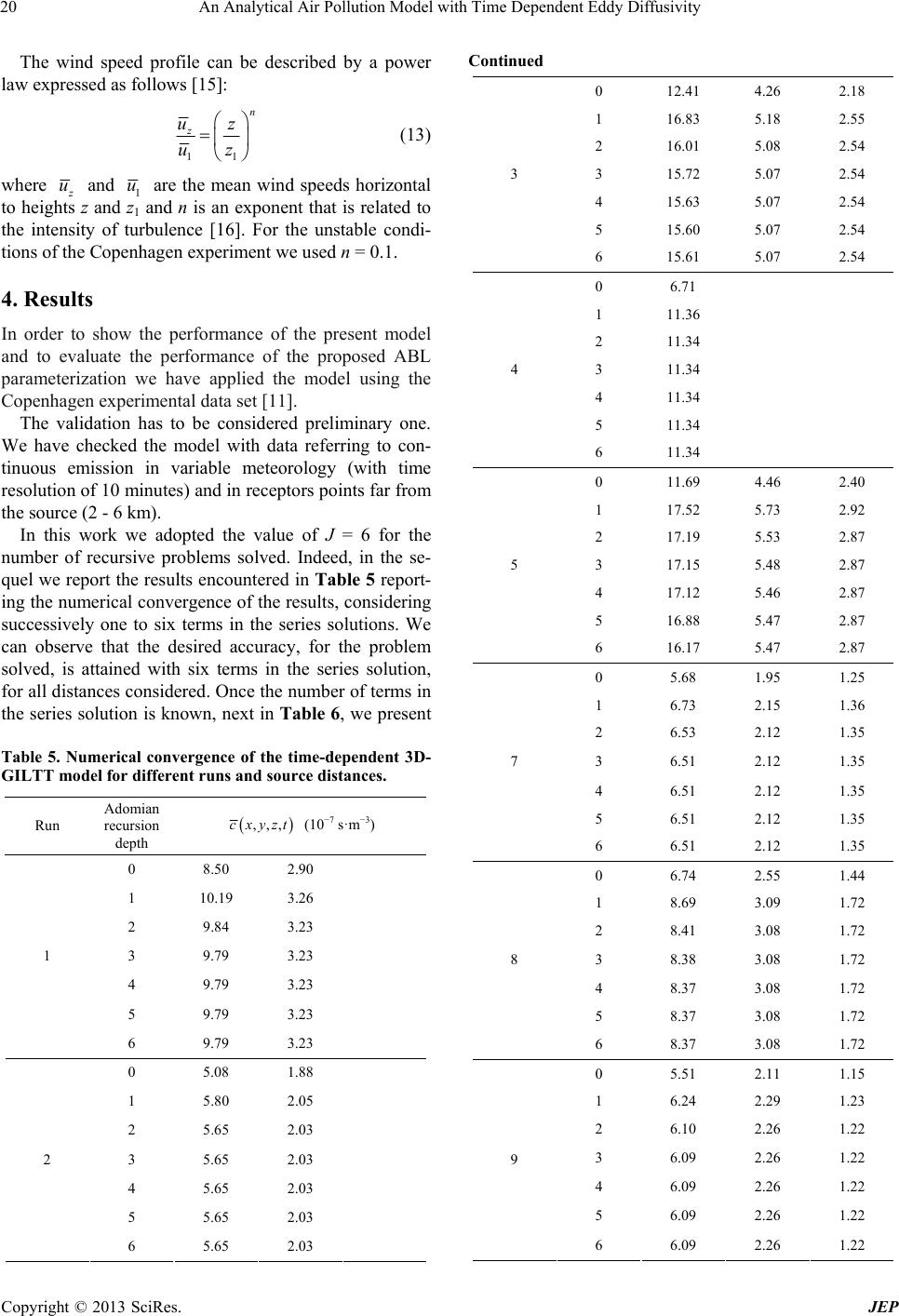 An Analytical Air Pollution Model with Time Dependent Eddy Diffusivity 20 The wind speed profile can be described by a power law expressed as follows [15]: 11 n z uz uz (13) where u and 1 u are the mean wind speeds horizontal to heights z and z1 and n is an exponent that is related to the intensity of turbulence [16]. For the unstable condi- tions of the Copenhagen experiment we used n = 0.1. 4. Results In order to show the performance of the present model and to evaluate the performance of the proposed ABL parameterization we have applied the model using the Copenhagen experimental data set [11]. The validation has to be considered preliminary one. We have checked the model with data referring to con- tinuous emission in variable meteorology (with time resolution of 10 minutes) and in receptors points far from the source (2 - 6 km). In this work we adopted the value of J = 6 for the number of recursive problems solved. Indeed, in the se- quel we report the results encountered in Table 5 report- ing the numerical convergence of the results, considering successively one to six terms in the series solutions. We can observe that the desired accuracy, for the problem solved, is attained with six terms in the series solution, for all distances considered. Once the number of terms in the series solution is known, next in Table 6, we present Table 5. Numerical convergence of the time-dependent 3D- GILTT model for different runs and source distances. Run Adomian recursion depth ,,,cxyzt Continued 0 12.41 4.26 2.18 1 16.83 5.18 2.55 2 16.01 5.08 2.54 3 15.72 5.07 2.54 4 15.63 5.07 2.54 5 15.60 5.07 2.54 3 6 15.61 5.07 2.54 0 6.71 1 11.36 2 11.34 3 11.34 4 11.34 5 11.34 4 6 11.34 0 11.69 4.46 2.40 1 17.52 5.73 2.92 2 17.19 5.53 2.87 3 17.15 5.48 2.87 4 17.12 5.46 2.87 5 16.88 5.47 2.87 5 6 16.17 5.47 2.87 0 5.68 1.95 1.25 1 6.73 2.15 1.36 2 6.53 2.12 1.35 3 6.51 2.12 1.35 4 6.51 2.12 1.35 5 6.51 2.12 1.35 7 6 6.51 2.12 1.35 0 6.74 2.55 1.44 1 8.69 3.09 1.72 2 8.41 3.08 1.72 3 8.38 3.08 1.72 4 8.37 3.08 1.72 5 8.37 3.08 1.72 8 6 8.37 3.08 1.72 0 5.51 2.11 1.15 1 6.24 2.29 1.23 2 6.10 2.26 1.22 3 6.09 2.26 1.22 4 6.09 2.26 1.22 5 6.09 2.26 1.22 9 6 6.09 2.26 1.22 (10−7 s·m−3) 0 8.50 2.90 1 10.19 3.26 2 9.84 3.23 3 9.79 3.23 4 9.79 3.23 5 9.79 3.23 1 6 9.79 3.23 0 5.08 1.88 1 5.80 2.05 2 5.65 2.03 3 5.65 2.03 4 5.65 2.03 5 5.65 2.03 2 6 5.65 2.03 Copyright © 2013 SciRes. JEP 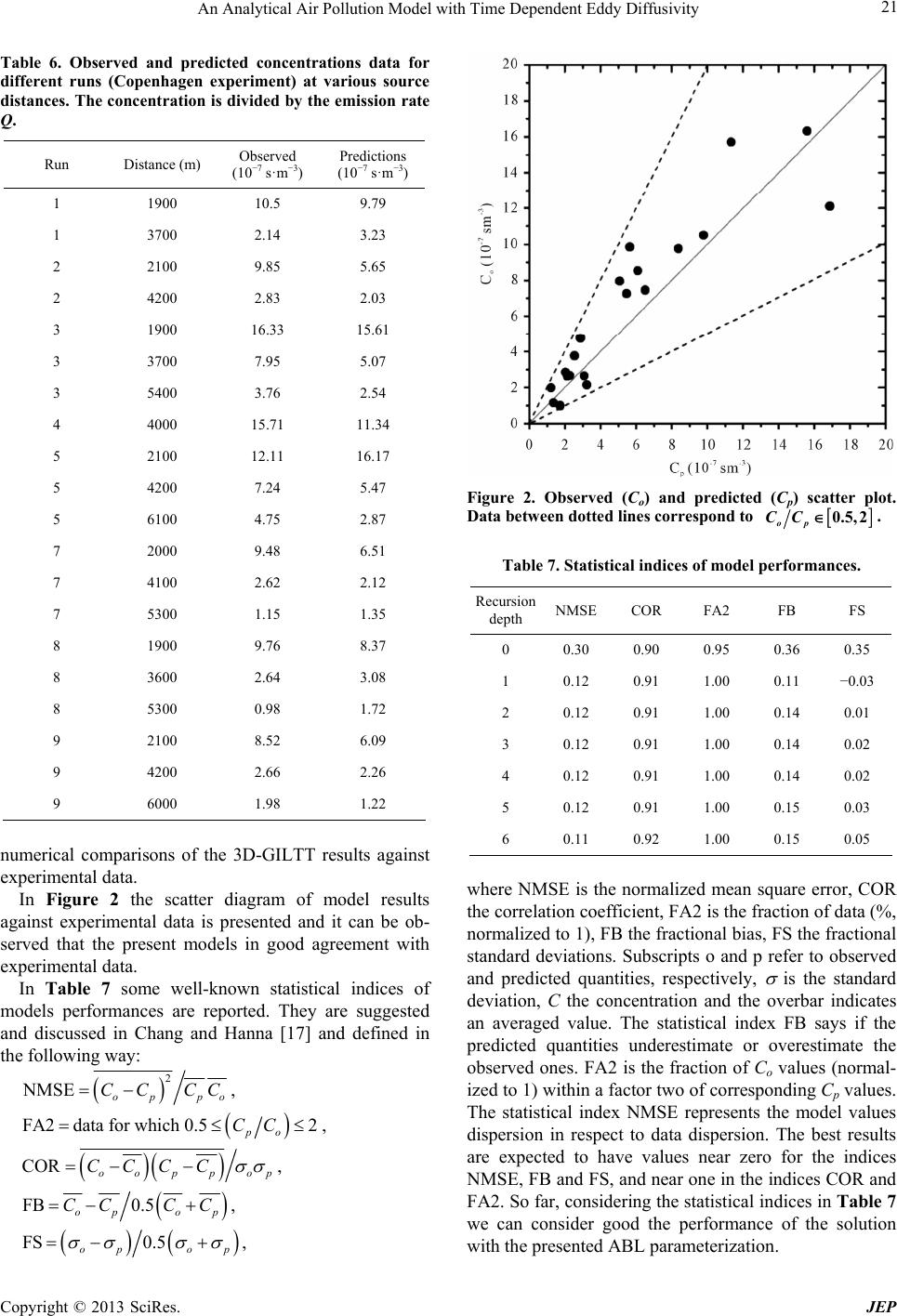 An Analytical Air Pollution Model with Time Dependent Eddy Diffusivity 21 Table 6. Observed and predicted concentrations data for different runs (Copenhagen experiment) at various source distances. The concentration is divided by the emission rate Q. Run Distance (m) Observed (10−7 s·m−3) Predictions (10−7 s·m−3) 1 1900 10.5 9.79 1 3700 2.14 3.23 2 2100 9.85 5.65 2 4200 2.83 2.03 3 1900 16.33 15.61 3 3700 7.95 5.07 3 5400 3.76 2.54 4 4000 15.71 11.34 5 2100 12.11 16.17 5 4200 7.24 5.47 5 6100 4.75 2.87 7 2000 9.48 6.51 7 4100 2.62 2.12 7 5300 1.15 1.35 8 1900 9.76 8.37 8 3600 2.64 3.08 8 5300 0.98 1.72 9 2100 8.52 6.09 9 4200 2.66 2.26 9 6000 1.98 1.22 numerical comparisons of the 3D-GILTT results against experimental data. In Figure 2 the scatter diagram of model results against experimental data is presented and it can be ob- served that the present models in good agreement with experimental data. In Table 7 some well-known statistical indices of models performances are reported. They are suggested and discussed in Chang and Hanna [17] and defined in the following way: 2 NMSE op p CC CC o , FA2data for which0.52 po CC, COR oo p po CCCC p , FB 0.5 op op CC CC , Figure 2. Observed (Co) and predicted (Cp) scatter plot. Data between dotted lines corre spond to 0.5,2 op CC . Table 7. Statistical indices of model performances. Recursion depth NMSECOR FA2 FB FS 0 0.30 0.90 0.95 0.36 0.35 1 0.12 0.91 1.00 0.11 −0.03 2 0.12 0.91 1.00 0.14 0.01 3 0.12 0.91 1.00 0.14 0.02 4 0.12 0.91 1.00 0.14 0.02 5 0.12 0.91 1.00 0.15 0.03 6 0.11 0.92 1.00 0.15 0.05 where NMSE is the normalized mean square error, COR the correlation coefficient, FA2 is the fraction of data (%, normalized to 1), FB the fractional bias, FS the fractional standard deviations. Subscripts o and p refer to observed and predicted quantities, respectively, is the standard deviation, C the concentration and the overbar indicates an averaged value. The statistical index FB says if the predicted quantities underestimate or overestimate the observed ones. FA2 is the fraction of Co values (normal- ized to 1) within a factor two of corresponding Cp values. The statistical index NMSE represents the model values dispersion in respect to data dispersion. The best results are expected to have values near zero for the indices NMSE, FB and FS, and near one in the indices COR and FA2. So far, considering the statistical indices in Table 7 we can consider good the performance of the solution with the presented ABL parameterization. FS 0.5 op op , Copyright © 2013 SciRes. JEP 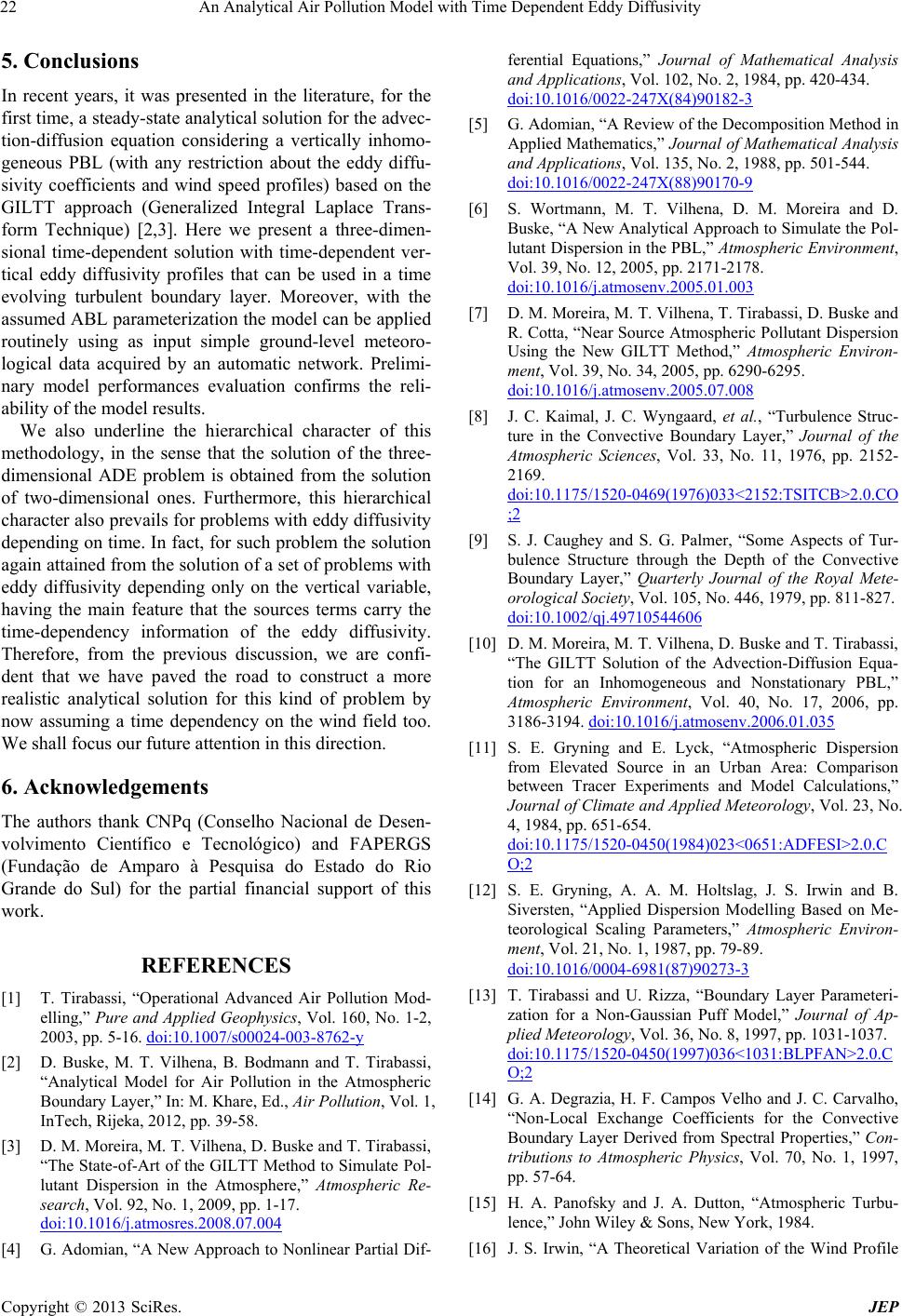 An Analytical Air Pollution Model with Time Dependent Eddy Diffusivity 22 5. Conclusions In recent years, it was presented in the literature, for the first time, a steady-state analytical solution for the advec- tion-diffusion equation considering a vertically inhomo- geneous PBL (with any restriction about the eddy diffu- sivity coefficients and wind speed profiles) based on the GILTT approach (Generalized Integral Laplace Trans- form Technique) [2,3]. Here we present a three-dimen- sional time-dependent solution with time-dependent ver- tical eddy diffusivity profiles that can be used in a time evolving turbulent boundary layer. Moreover, with the assumed ABL parameterization the model can be applied routinely using as input simple ground-level meteoro- logical data acquired by an automatic network. Prelimi- nary model performances evaluation confirms the reli- ability of the model results. We also underline the hierarchical character of this methodology, in the sense that the solution of the three- dimensional ADE problem is obtained from the solution of two-dimensional ones. Furthermore, this hierarchical character also prevails for problems with eddy diffusivity depending on time. In fact, for such problem the solution again attained from the solution of a set of problems with eddy diffusivity depending only on the vertical variable, having the main feature that the sources terms carry the time-dependency information of the eddy diffusivity. Therefore, from the previous discussion, we are confi- dent that we have paved the road to construct a more realistic analytical solution for this kind of problem by now assuming a time dependency on the wind field too. We shall focus our future attention in this direction. 6. Acknowledgements The authors thank CNPq (Conselho Nacional de Desen- volvimento Científico e Tecnológico) and FAPERGS (Fundação de Amparo à Pesquisa do Estado do Rio Grande do Sul) for the partial financial support of this work. REFERENCES [1] T. Tirabassi, “Operational Advanced Air Pollution Mod- elling,” Pure and Applied Geophysics, Vol. 160, No. 1-2, 2003, pp. 5-16. doi:10.1007/s00024-003-8762-y [2] D. Buske, M. T. Vilhena, B. Bodmann and T. Tirabassi, “Analytical Model for Air Pollution in the Atmospheric Boundary Layer,” In: M. Khare, Ed., Air Pollution, Vol. 1, InTech, Rijeka, 2012, pp. 39-58. [3] D. M. Moreira, M. T. Vilhena, D. Buske and T. Tirabassi, “The State-of-Art of the GILTT Method to Simulate Pol- lutant Dispersion in the Atmosphere,” Atmospheric Re- search, Vol. 92, No. 1, 2009, pp. 1-17. doi:10.1016/j.atmosres.2008.07.004 [4] G. Adomian, “A New Approach to Nonlinear Partial Dif- ferential Equations,” Journal of Mathematical Analysis and Applications, Vol. 102, No. 2, 1984, pp. 420-434. doi:10.1016/0022-247X(84)90182-3 [5] G. Adomian, “A Review of the Decomposition Method in Applied Mathematics,” Journal of Mathematical Analysis and Applications, Vol. 135, No. 2, 1988, pp. 501-544. doi:10.1016/0022-247X(88)90170-9 [6] S. Wortmann, M. T. Vilhena, D. M. Moreira and D. Buske, “A New Analytical Approach to Simulate the Pol- lutant Dispersion in the PBL,” Atmospheric Environment, Vol. 39, No. 12, 2005, pp. 2171-2178. doi:10.1016/j.atmosenv.2005.01.003 [7] D. M. Moreira, M. T. Vilhena, T. Tirabassi, D. Buske and R. Cotta, “Near Source Atmospheric Pollutant Dispersion Using the New GILTT Method,” Atmospheric Environ- ment, Vol. 39, No. 34, 2005, pp. 6290-6295. doi:10.1016/j.atmosenv.2005.07.008 [8] J. C. Kaimal, J. C. Wyngaard, et al., “Turbulence Struc- ture in the Convective Boundary Layer,” Journal of the Atmospheric Sciences, Vol. 33, No. 11, 1976, pp. 2152- 2169. doi:10.1175/1520-0469(1976)033<2152:TSITCB>2.0.CO ;2 [9] S. J. Caughey and S. G. Palmer, “Some Aspects of Tur- bulence Structure through the Depth of the Convective Boundary Layer,” Quarterly Journal of the Royal Mete- orological Society, Vol. 105, No. 446, 1979, pp. 811-827. doi:10.1002/qj.49710544606 [10] D. M. Moreira, M. T. Vilhena, D. Buske and T. Tirabassi, “The GILTT Solution of the Advection-Diffusion Equa- tion for an Inhomogeneous and Nonstationary PBL,” Atmospheric Environment, Vol. 40, No. 17, 2006, pp. 3186-3194. doi:10.1016/j.atmosenv.2006.01.035 [11] S. E. Gryning and E. Lyck, “Atmospheric Dispersion from Elevated Source in an Urban Area: Comparison between Tracer Experiments and Model Calculations,” Journal of Climate and Applied Meteorology, Vol. 23, No. 4, 1984, pp. 651-654. doi:10.1175/1520-0450(1984)023<0651:ADFESI>2.0.C O;2 [12] S. E. Gryning, A. A. M. Holtslag, J. S. Irwin and B. Siversten, “Applied Dispersion Modelling Based on Me- teorological Scaling Parameters,” Atmospheric Environ- ment, Vol. 21, No. 1, 1987, pp. 79-89. doi:10.1016/0004-6981(87)90273-3 [13] T. Tirabassi and U. Rizza, “Boundary Layer Parameteri- zation for a Non-Gaussian Puff Model,” Journal of Ap- plied Meteorology, Vol. 36, No. 8, 1997, pp. 1031-1037. doi:10.1175/1520-0450(1997)036<1031:BLPFAN>2.0.C O;2 [14] G. A. Degrazia, H. F. Campos Velho and J. C. Carvalho, “Non-Local Exchange Coefficients for the Convective Boundary Layer Derived from Spectral Properties,” Con- tributions to Atmospheric Physics, Vol. 70, No. 1, 1997, pp. 57-64. [15] H. A. Panofsky and J. A. Dutton, “Atmospheric Turbu- lence,” John Wiley & Sons, New York, 1984. [16] J. S. Irwin, “A Theoretical Variation of the Wind Profile Copyright © 2013 SciRes. JEP 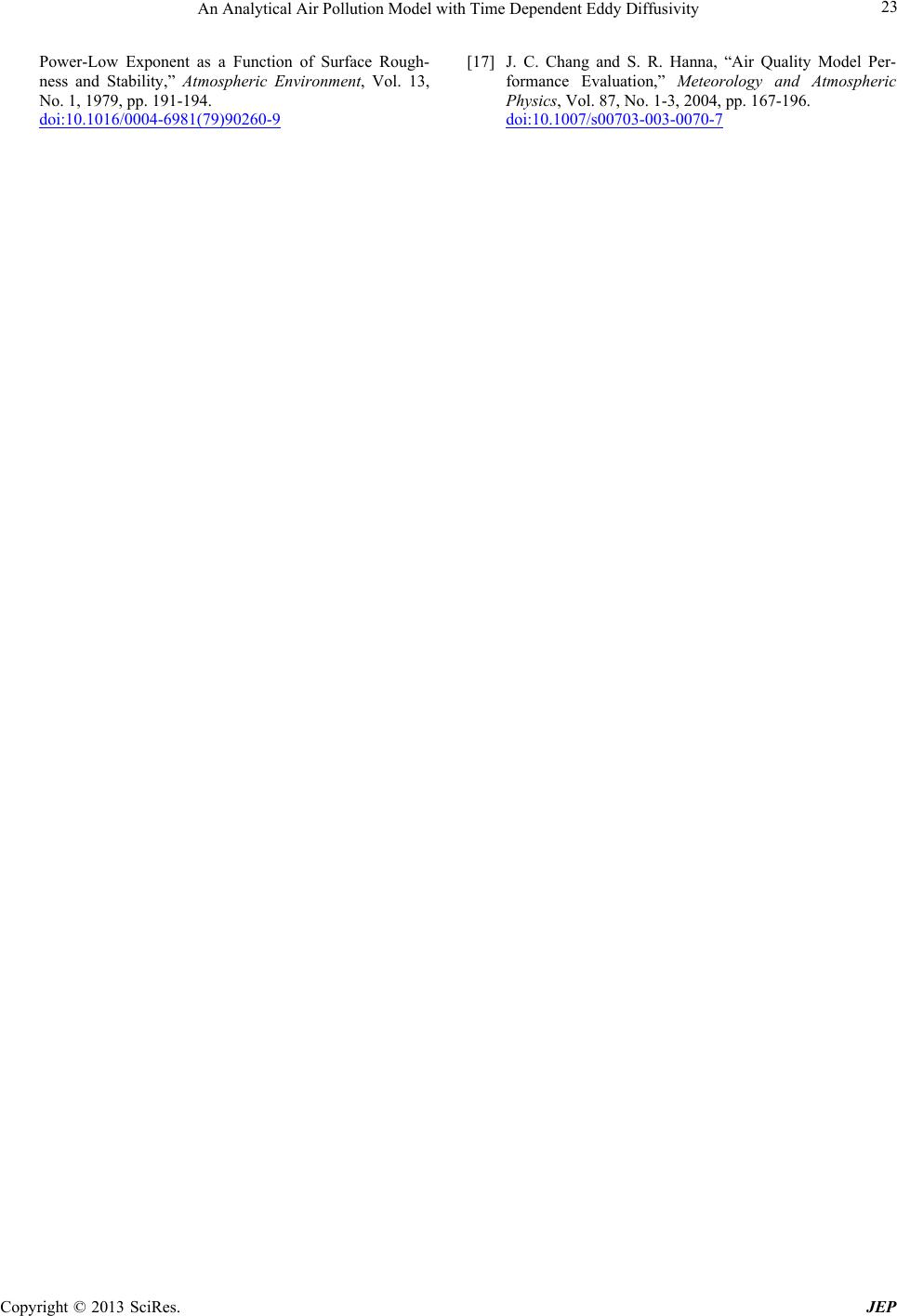 An Analytical Air Pollution Model with Time Dependent Eddy Diffusivity Copyright © 2013 SciRes. JEP 23 Power-Low Exponent as a Function of Surface Rough- ness and Stability,” Atmospheric Environment, Vol. 13, No. 1, 1979, pp. 191-194. doi:10.1016/0004-6981(79)90260-9 [17] J. C. Chang and S. R. Hanna, “Air Quality Model Per- formance Evaluation,” Meteorology and Atmospheric Physics, Vol. 87, No. 1-3, 2004, pp. 167-196. doi:10.1007/s00703-003-0070-7
|